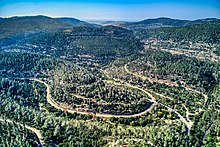
Back وادي الصرار Arabic نهر روبين ARZ Naẖal Soreq (wadi sa Israel) CEB Sorek Czech Сорек (юханшыв) CV Nachal Sorek German Soreq Spanish نخل سوقک Persian Sorek French נחל שורק HE


Naḥal Sorek (Hebrew: נחל שורק, lit. 'Brook of Sorek'; Arabic: وادي الصرار, romanized: Wadi al-Sirar), also Soreq, is one of the largest, most important drainage basins in the Judean Hills.[1] It is mentioned in the Book of Judges 16:4 of the Bible as the border between the ancient Philistines and the Tribe of Dan of the ancient Israelites. It is known in Arabic as Wadi es-Sarār, sometimes spelled Surar,[2] and by various names along different segments, such as Wadi Qalunya near Motza,[3] Wadi al-Tahuna, and Nahr Rubin further downstream.
- ^ Protecting The Environment
- ^ Office for Subject Cataloging Plicy, Collections Services (1992). Library of Congress Subject Headings. Vol. IV Q-Z (15 ed.). Washington, D.C.: Library of Congress. Retrieved 24 May 2018.
- ^ Oded Lowenheim (2014). The Politics of the Trail: Reflexive Mountain Biking along the Frontier of Jerusalem. University of Michigan Press. ISBN 9780472052127. Retrieved 24 May 2018.
....the Soreq riverbed, which on the British map I brought them is called Wadi Qalunya.